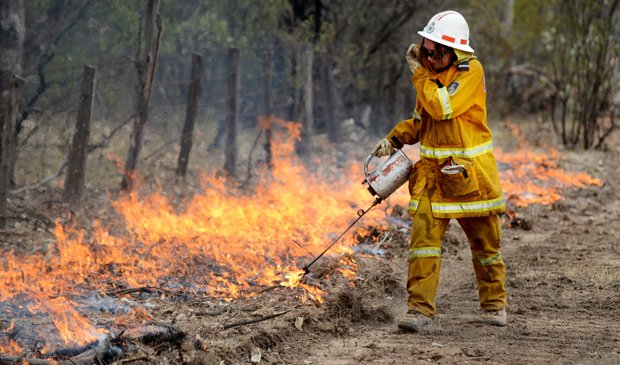Monster bushfire ravages Warrumbungle NP

A HUGE BUSHFIRE HAS had a catastrophic impact on Warrumbungle National Park in central NSW, just weeks after Australian Geographic published a major feature story and photographs of the park (AG 112).
The fire, still out of control, has been burning for a week. So far, it has ripped through an estimated 43,000ha of the national park and its surrounds, destroying the visitor centre and 33 homes, and damaging infrastructure at the Siding Spring Observatory (SSO).
See images of Warrumbungle National Park before it was destroyed
“By the time this is over, there won’t be much of the park that won’t have burnt,” says Mark Fosdick, Coonabarabran area manager for Parks and Wildlife, still in the thick of the action. “Maybe 80 or 90 per cent is gone now.”
“The visitor centre is just a shell – completely destroyed. The shearer’s quarters are gone, the woolshed is gone. The historic Strathmore Homestead and workshop have survived,” says Mark. ” We’re just not sure about the ecological damage yet. Some areas burnt very hot, some areas didn’t.”
Trees and wildlife destroyed by fire
Park ranger Roger Row, who has worked in the park for 40 years, says the main species of tree in the park, a black pine, burns very hot and is killed by fire.
“There won’t be much left of the park, vegetation-wise,” he says, dressed in his fire-fighting gear and preparing to defend his home, which is surrounded by bush. “The temperature inside the [SSO’s] Australian Telescope was something like 110°C, so you can imagine what it was like outside.”
Roger says the understory will recover first, with wattles and shrubs, particularly in places where the fire burnt more slowly down hills or at night. The trees, however, were unlikely to recover in places where the fire burnt very hot.
“I don’t think there will be any bare ground left that can support wildlife,” he says. “I don’t think there will be a koala population left, and the rock-wallabies that we have been managing in a corner of the park – I don’t know how they would have fared.”
Biggest fire in over 50 years
Roger says the fire, which is by far the largest to have engulfed the region since a wide-reaching blaze in 1967, is believed to have started near Camp Wambelong on the western side of the park. It is believed the fire was started at around 4pm on Saturday by a lightning strike, or possibly when two electric wires touched.
As with many rural fires, however, rumours are abounding as to who is at fault, and Roger says there will be an inquiry. “Whether it’s the greenhouse effect, climate change, or whatever, it’s by far the biggest fire [in the region] in white man’s history.”
Roger says he is considering delaying retirement this year in order to help rebuild infrastructure in the 23,000ha park.
Mark Fosdick says it will be months before the park reopens. “The short term reason it’ll be closed is in terms of danger – the potential for falling trees,” he says.
“Then I can’t see the campgrounds opening for a few months. It’s taken 30-40 years to build what we’ve got here. Even walking tracks take so long to build, and we haven’t been able to check to see if any bridges survived.”
See images of Warrumbungle National Park before it was destroyed
REALTED ARTICLES

